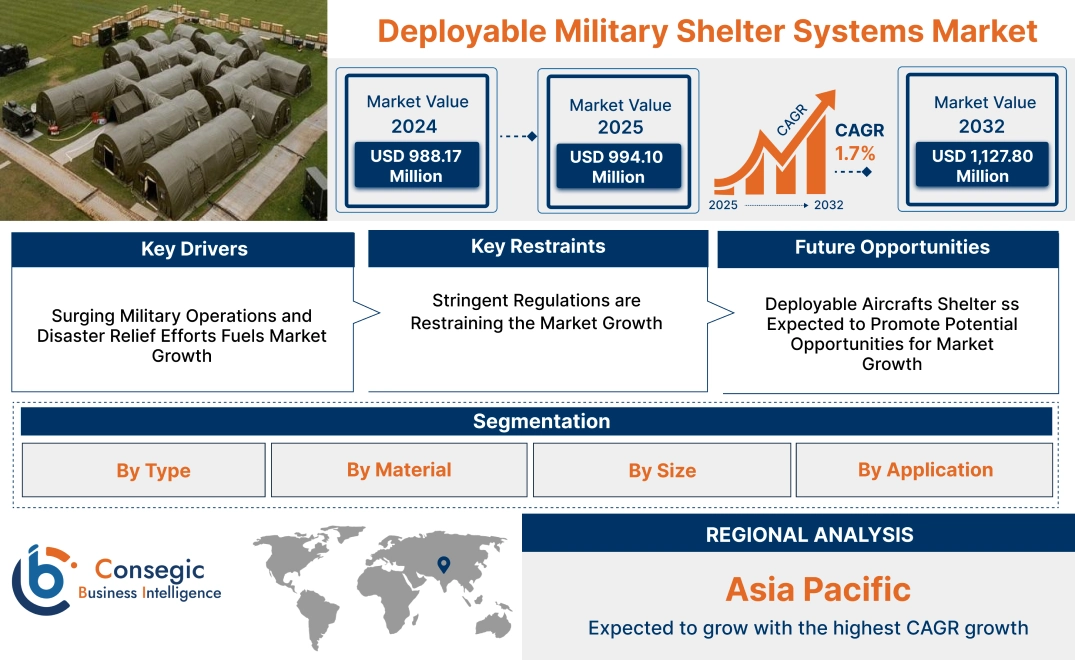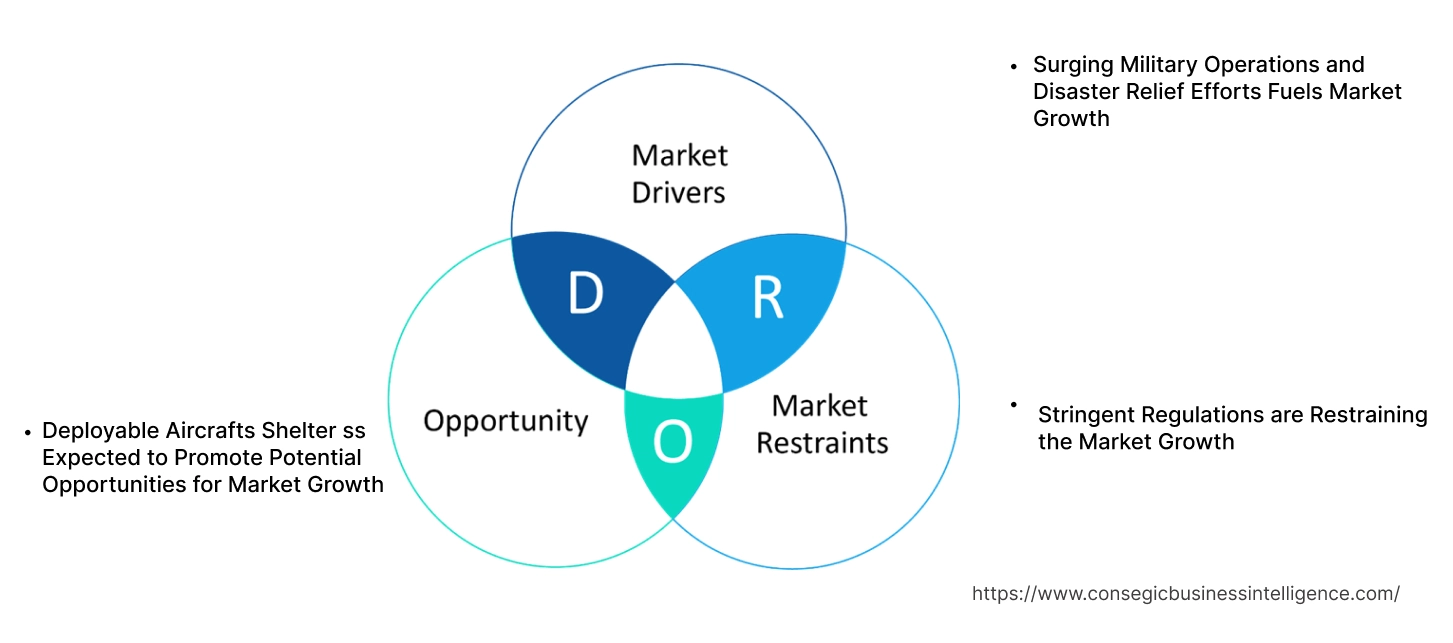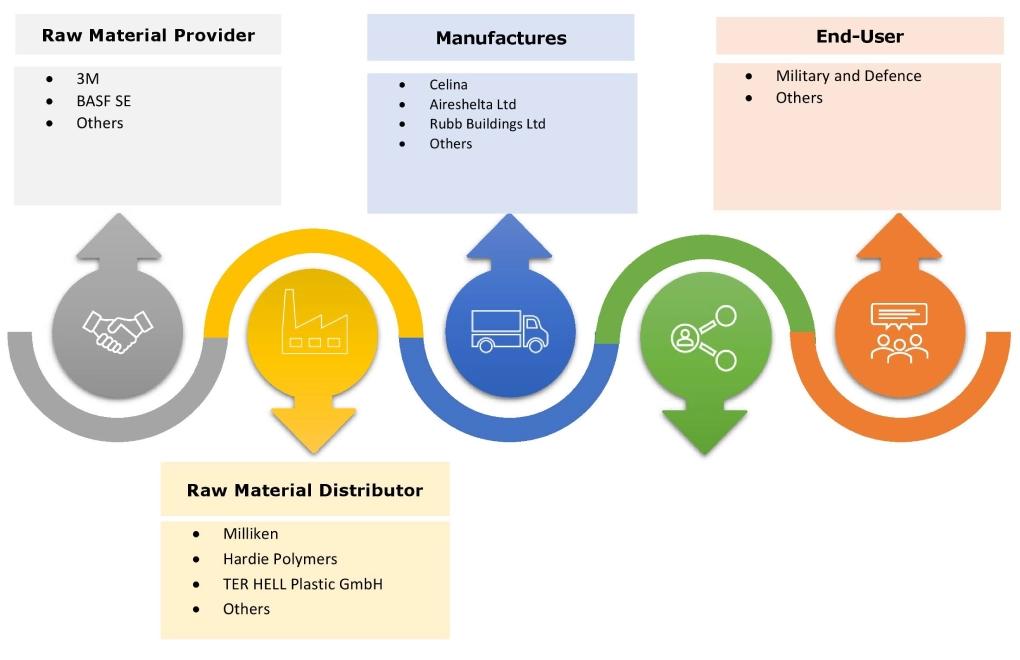- Summary
- Table Of Content
- Methodology
Deployable Military Shelter Systems Market Size:
Deployable Military Shelter Systems Market is estimated to reach over USD 1,127.80 Million by 2032 from a value of USD 988.17 Million in 2024 and is projected to grow by USD 994.10 Million in 2025, growing at a CAGR of 1.7% from 2025 to 2032.
Deployable Military Shelter Systems Market Scope & Overview:
Deployable military shelter systems is designed to provide military-grade safety and protection to people and organizations during disaster relief, military operation and other. The primary role of military shelter system is to provide safety, security, and resilience amidst the world's harshest conditions. Additionally, advantages of deployable shelter system including high mobility, durability, sustainability, and ease of deployment among others are driving the deployable military shelter systems market growth. Moreover, the shelters features climate control, lighting, flooring, and camp services such as dining halls, kitchen tents and more. Further, the ability of shelters to withstand extreme climates for long durations of time, making them a reliable shelter option during war or toughest weather conditions in turn fueling the deployable military shelter systems market demand.
Key Drivers:
Surging Military Operations and Disaster Relief Efforts Fuels Market Growth
The rise in border conflicts across the globe and increasing frequency of military operations is propelling the demand for rapidly deployable military shelter due to durability and speed of installation. Additionally, natural disasters such as earthquakes, floods and hurricanes among others utilizes deployable shelters for temporary shelter solution for emergency housing, medical centers, military base stations and other in turn boosting the deployable military shelter systems market demand.
- For instance, in August 2023, Alaska Defense launched a series of multi-purposerapidly deployable military shelter systemsof different sizes. The shelters offer unparalleled portability, durability, and versatility. Additionally, the shelters are equipped with lights, an electrical kit, and insulation system, among others.
Thus, the rising border tensions and temporary shelter solution in turn proliferating the deployable military shelter systems market growth.
Key Restraints:
Stringent Regulations are Restraining the Market Growth
The increasing complexity and rigorous military grade standards such as NATO standards, DoD standards and other are adhered for manufacturing of shelters. The stringent standards focus on durability, security, and mobility of shelters in turn hinders the deployable military shelter systems market expansion. Further, the shelters undergo rigorous tests for durability, performance, safety and reliability as well as speed of deployment and others restricts the deployable military shelter systems market progress.
Therefore, the stringent regulations and test for durability and other hinders the deployable military shelter systems market expansion.
Future Opportunities :
Deployable Aircrafts Shelter ss Expected to Promote Potential Opportunities for Market Growth
The increasing demand for aircraft protection from extreme weather conditions such as sandstorms, hurricanes and other environmental factor propels the deployable military shelter systems market opportunities. Additionally, the rising cost of advanced aircrafts as well as the expensive equipment equipped to the aircrafts drives the demand for aircraft shelter systems for protection and safety. Furthermore, the rapid deployment and camouflage capabilities of shelters propels the market progress.
- For instance, in March 2023, Pacific Air Forces launchedaircraft shelter system for providing protection to 4th and 5th generation aircraft and mission essential equipment. The aim of the launch is to provide smaller, dispersed, resilient, adaptive basing at a moment’s notice.
Hence, the rising adoption of aircraft shelter systems is anticipated to increase the utilization in turn promoting deployable military shelter systems market opportunities for growth during the forecast period.
Deployable Military Shelter Systems Market Segmental Analysis :
By Type:
Based on the type, the market is bifurcated into hardwall shelters and softwall shelters.
Trends in the Type:
- The rapid deployment and ease of assembly is propelling the demand for soft wall shelters in turn driving the deployable military shelter systems market trend.
- Hard wall shelters is utilized in multi-purpose activity such as medical centers, storage facility and other in turn driving the deployable military shelter systems market trend.
The softwall shelters accounted for the largest revenue share in the year 2024.
- The rising demand for softwall shelters in disaster relief activities and increasing border protection activity is propelling the deployable military shelter systems market share.
- Moreover, increasing functionality of softwall shelters in military, medical facility, and disaster relief camp fuels the deployable military shelter systems market size.
- Further, the primary factor driving the softwall shelter segment include cost-effectiveness, lightweight design, flexibility and portability among others.
- For instance, Celina and HDT Global are manufacturers ofsoft wall shelters equipped with modular ballistic panels, folding frame and other.
- Thus, according to the deployable military shelter systems market analysis, increasing functionality and increasing border protection activity is driving the market.
Hardwall shelters is anticipated to register the fastest CAGR during the forecast period.
- The hardwall shelters features a range of rugged, rapidly deployable tactical structures. The versatility of hardwall shelters accommodate huge sleeping areas, functional office spaces, and medical facilities.
- Moreover, shelters are integrated with advanced technology such as insulation systems, climate control systems and others which in turn fuels the deployable military shelter systems market size.
- Further, the primary factor driving the adoption of hardwall shelters include longevity, durability and mobility among others.
- For instance, in April 2024, HDT Global received a contract of USD 432 million for supplingrigid wall shelters to U.S. Army. The contract include expandable and non-expandable rigid wall shelters.
- Therefore, as per the market analysis, the aforementioned primary factor and integration with advanced technologies is anticipated to boost the market during the forecast period.
By Material:
Based on the material, the market is segmented into polymer fabric, aluminum or carbon composites, nylon, and others.
Trends in the Material:
- Nylon fabric are easy to deploy for softwall shelters due to ease of transportation and maintain among others in turn fueling the market evolution.
- The trend towards increasing adoption of nylon due to its strength, resistivity, and elasticity among other in turn propelling the segments progress.
The polymer fabric accounted for the largest revenue share in the year 2024.
- The polymer fabric are highly durable, easy to operate and easy to maintain, which ensure longevity in turn driving the deployable military shelter systems market share.
- Moreover, the polymer fabric are cost-effective solution with minimal transportation efforts in remote locations in turn driving polymer fabric market adoption for military shelters.
- Further, the primary factor driving the adoption of polymer fabric include lightweight, flexibility and weather resistant, among others.
- For instance,Shanghai DER New Material Co., Ltd is a leading provider of PVC coated polyester for tents. The properties of material include strength and resistance to tearing, punctures, and abrasion as well as protection against UV radiation and others.
- Thus, as per the market analysis, cost-effective with less maintenance associated with polymer fabric is driving the market development.
The aluminum or carbon composites is anticipated to register the fastest CAGR during the forecast period.
- The aluminum or carbon composite are suitable for seamless integration of advanced technology and withstanding harsh weather conditions.
- Moreover, the properties of aluminum or carbon composite material include lightweight, durability, and high strength among other in turn driving the segments progress.
- Further, the rapidly growing hardwall shelters is propelling the adoption of aluminum or carbon composite material.
- For instance,Will-Burt Company with subsidiary GEROH is a leading manufacturer of shelters made of all-composite materials which deliver higher performance at lower cost than traditional shelters.
- Therefore, according to the deployable military shelter systems market analysis, rapid deployment in hardwall shelters is anticipated to boost the market during the forecast period.
By Size:
Based on the size, the market is segmented into small, medium, large.
Trends in the Size:
- The trend towards adoption of large size shelters for protecting military equipment’s such as aircrafts and vehicles.
- The small size shelters are widely utilized for disaster relief sheltering solution due to their lightweight design and ease of deployment in turn driving the market trend.
The small size accounted for the largest revenue share of 44.12% in the year 2024 and is anticipated to register the fastest CAGR during the forecast period.
- The small size shelters are majorly utilized by the military and defence personnel during military missions or operations in tun driving the progress of segment.
- Moreover, research centers, UAV and weather monitoring system utilizes small size shelters in turn fueling the market development.
- Further, the primary factor driving the adoption of small shelters include lightweight and compact design, ease of deployment and transportation among others.
- For instance,Aireshelta launched new range of military and security shelters. The shelter sizes range from boxes and small sanitization units.
- Thus, as per the analysis, aforementioned factor is driving the small size shelters segment progress.
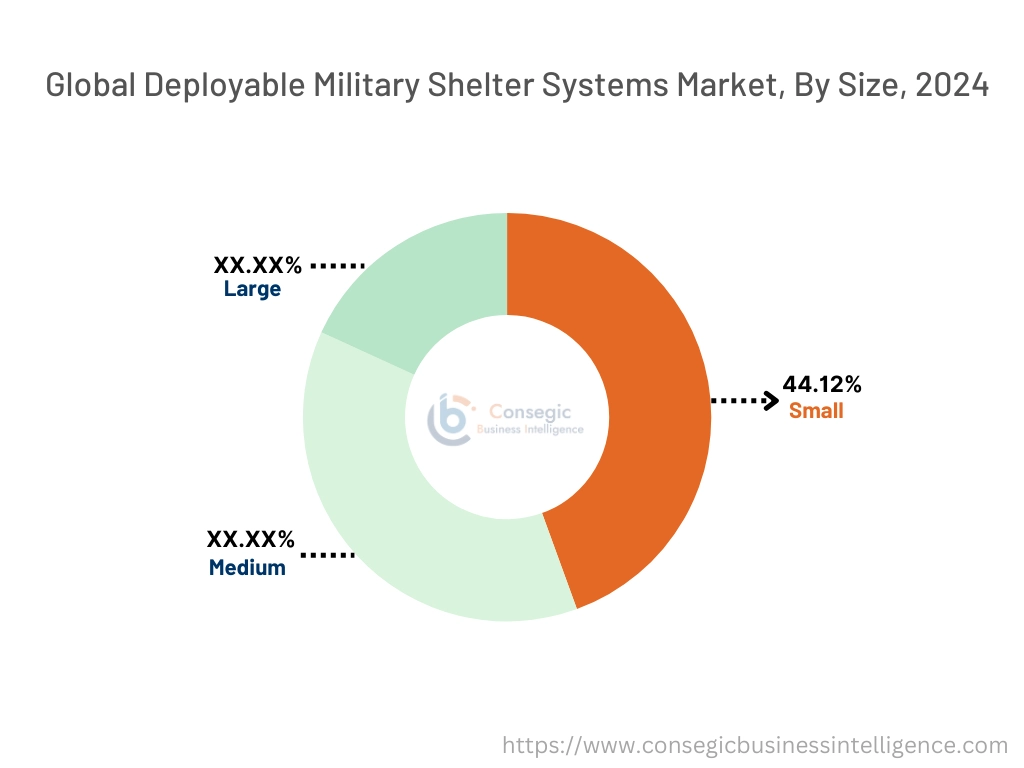
By Application:
Based on the application, the market is segmented into field accommodation, command and control operations, aircraft maintenance, logistics facility, medical facility, and others.
Trends in the Application:
- The customization and modification trend is driving the market progress for application in command and control operations.
- The shelters have the ability to integrate advanced technologies such as communication devices, monitoring systems, incubator and other in turn driving the market progress for command and control operations applications.
The field accommodation accounted for the largest revenue share in the year 2024.
- The field accommodation shelters include portable and military tent systems, which play a vital role in providing temporary housing for personnel.
- Further, the increasing border conflicts as well as increasing investment in adopting advance sheltering systems is driving the deployable military shelter systems industry.
- For instance,Celina is a leading manufacturer of Dynamic Small Shelter or Dynamic Medium Shelter and other for application in military and defence operations.
- Thus, as per the market analysis, increasing border conflicts as well as increasing investment in adopting advance sheltering systems is driving the market progress.
The medical facility is anticipated to register the fastest CAGR during the forecast period.
- Military shelter with medical facility is majorly used in disasters and emergencies in turn driving the market development.
- The shelters features Vinyl flooring, HVAC system, plug-and-play lighting system with carry bags.
- Further, the stringent rule and regulations associated with the manufacturing of shelters used as medical facilities to ensure safety, clean environment in the premise and other.
- For instance,BLU-MED Response Systems is a leading provider of rapidly deployable field hospitals and medical facilities for medical care, patient isolation, and other treatment options.
- Therefore, the stringent rule and regulations is anticipated to boost the market during the forecast period.
Regional Analysis:
The regions covered are North America, Europe, Asia Pacific, Middle East and Africa, and Latin America.
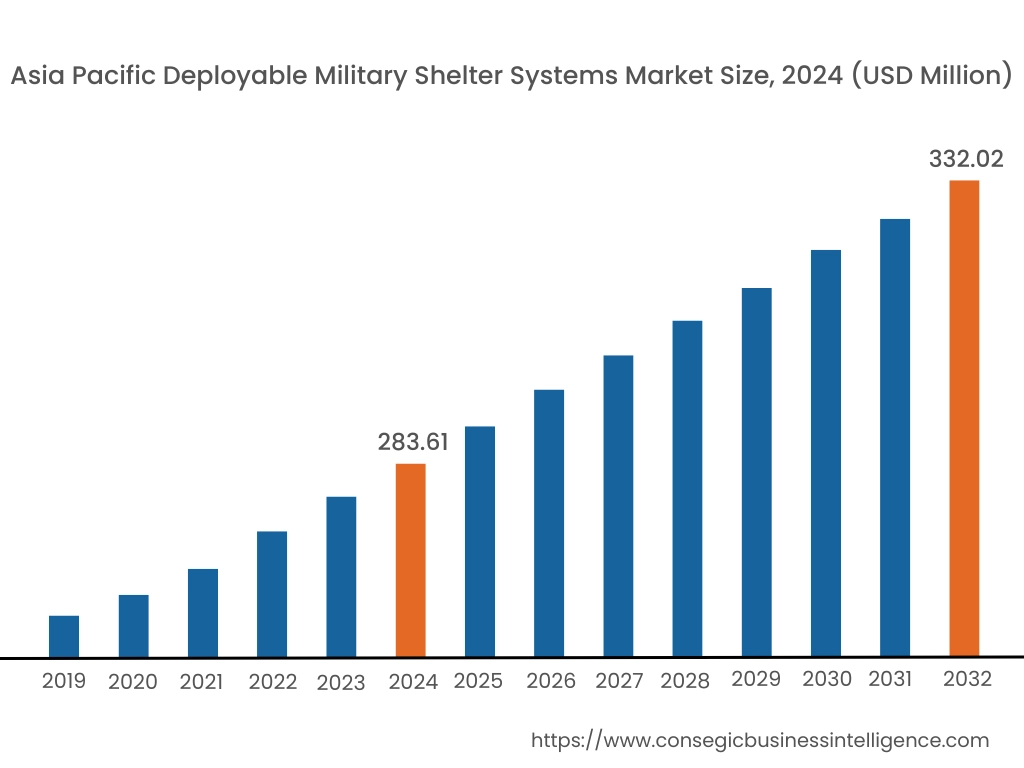
Asia Pacific region was valued at USD 283.61 Million in 2024. Moreover, it is projected to grow by USD 285.92 Million in 2025 and reach over USD 332.02 Million by 2032. Out of this, China accounted for the maximum revenue share of 31.1%. The market growth for military shelters is mainly driven by its deployment in disaster relief and military operations and other application. Furthermore, factors including increasing investment in military and defence industry is projected to drive the market during the forecast period.
- For instance, according toInstitute for Defence Studies and Analysis, the defence budget increased by 4.72% in the year 2024-25 as compared to previous year in turn driving the increasing investment in military and defence sector.
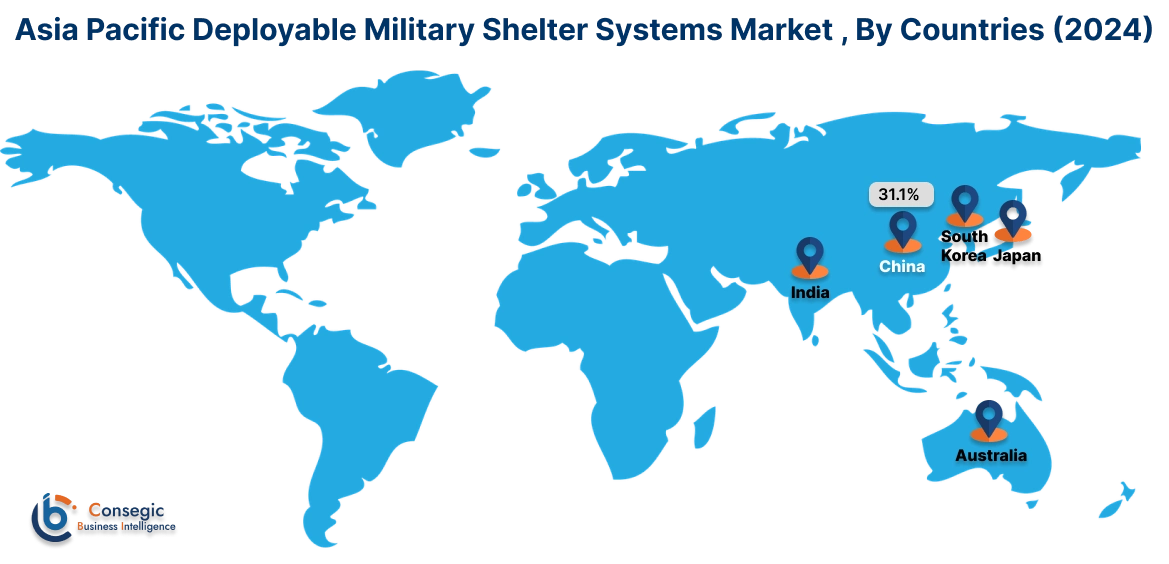
North America is estimated to reach over USD 351.87 Million by 2032 from a value of USD 309.47 Million in 2024 and is projected to grow by USD 311.23 Million in 2025. The North America region's increasing occurrence of natural disasters and increasing border conflicts offer lucrative growth prospects for the market.
- For instance, in October 2024, according toUS department of defence, they have provided 6,700 guardsmen from across the U.S for helping affected civilians from American Southeast part affected by Hurricane Helene. US have provided shelters and medical facilities and other.
The regional analysis depicts that the increasing conflicts in eastern Europe is driving the market progress in European region. Additionally, the primary factor driving the market in the Middle East and African region harsh weather conditions. Further, the frequent occurrence of natural disasters is paving the way for the progress of market in Latin America region.
Top Key Players and Market Share Insights:
The global deployable military shelter systems market is highly competitive with major players providing deployable military shelter systems to the national and international markets. Key players are adopting several strategies in research and development (R&D), product innovation, and end-user launches to hold a strong position in the deployable military shelter systems industry. Key players in the deployable military shelter systems market include-
- Alaska Structures (USA)
- CAMSS Shelters (USA)
- Celina (USA)
- Aireshelta Ltd (UK)
- Rubb Buildings Ltd. (UK)
- HDT Global (USA)
- UTS Systems (USA)
- MSS Defence (Netherlands)
- AAR (USA)
- Western Shelter Systems (USA)
Recent Industry Developments :
Deployment:
- In February 2023, NATO deployedshelters to help accommodate people displaced by the devastating earthquakes at Turkey. The shelters are equipped with heating, power generators, and medical treatment areas.
Partnerships & Collaborations:
- In June 2023, Saab partnered with Conlog Oy to provide mobile and durable expandable shelters and latest hydraulic mast system to be the base of most interesting system.
Deployable Military Shelter Systems Market Report Insights :
| Report Attributes | Report Details |
| Study Timeline | 2019-2032 |
| Market Size in 2032 | USD 1,127.80 Million |
| CAGR (2025-2032) | 1.7% |
| By Type |
|
| By Material |
|
| By Size |
|
| By Application |
|
| By Region |
|
| Key Players |
|
| North America | U.S. Canada Mexico |
| Europe | U.K. Germany France Spain Italy Russia Benelux Rest of Europe |
| APAC | China South Korea Japan India Australia ASEAN Rest of Asia-Pacific |
| Middle East and Africa | GCC Turkey South Africa Rest of MEA |
| LATAM | Brazil Argentina Chile Rest of LATAM |
| Report Coverage |
|
Key Questions Answered in the Report
How big is the deployable military shelter systems market? +
The Deployable Military Shelter Systems Market is estimated to reach over USD 1,127.80 Million by 2032 from a value of USD 988.17 Million in 2024 and is projected to grow by USD 994.10 Million in 2025, growing at a CAGR of 1.7% from 2025 to 2032.
What specific segmentation details are covered in the deployable military shelter systems report? +
The deployable military shelter systems report includes specific segmentation details for type, material, size, application, end-user, and regions.
Which is the fastest segment anticipated to impact the market growth? +
In the deployable military shelter systems market, the small size shelters is the fastest-growing segment during the forecast period due to benefits including compact design, ease of deployment and transportation among others.
Who are the major players in the deployable military shelter systems market? +
The key participants in the deployable military shelter systems market are Alaska Structures (USA), CAMSS Shelters (USA), HDT Global (USA), UTS Systems (USA), MSS Defence (Netherlands), AAR (USA), Western Shelter Systems (USA), Celina (USA), Aireshelta Ltd (UK), Rubb Buildings Ltd. (UK) and others.
What are the key trends in the deployable military shelter systems market? +
The deployable military shelter systems market is being shaped by several key trends including trend towards shelters have the ability to integrate advanced technologies such as communication devices, monitoring systems, incubator as well as adoption of large size shelters for protecting military equipment’s such as aircrafts and vehicles are the key trends driving the market.
